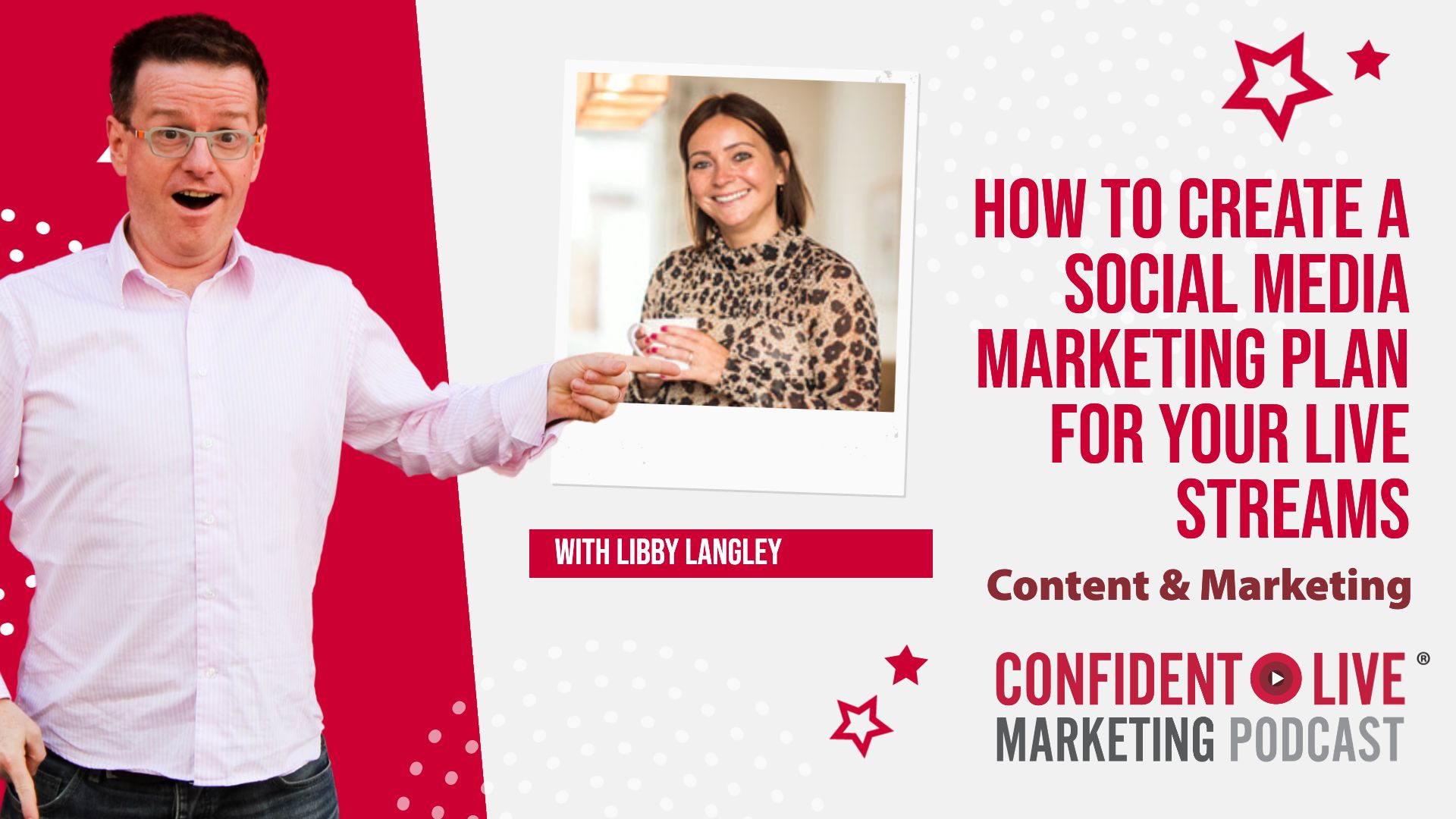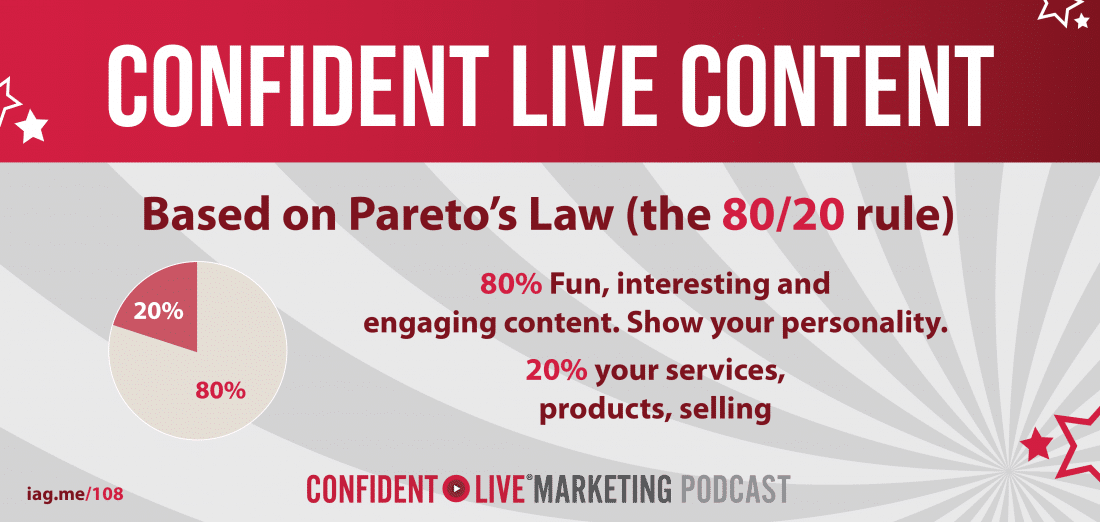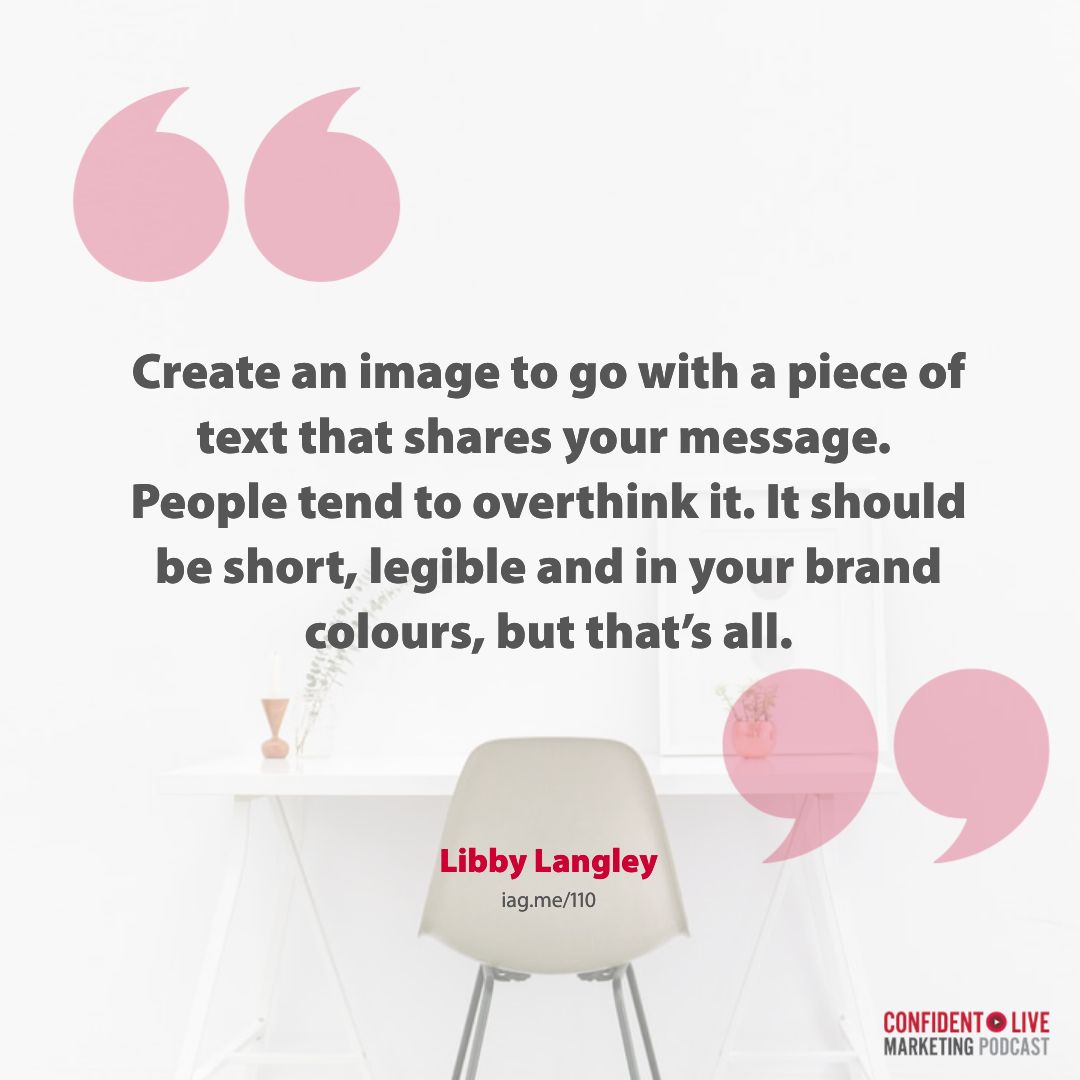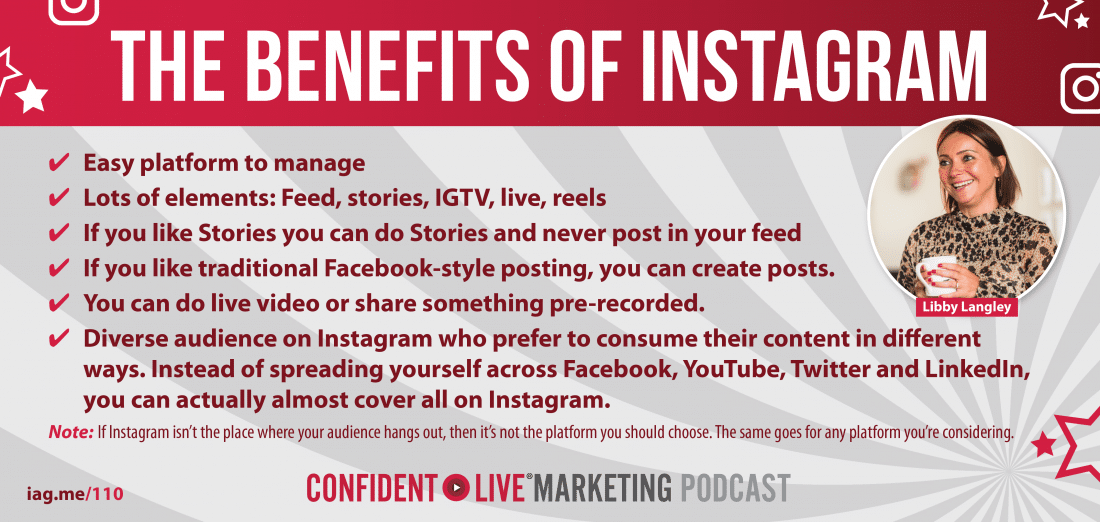How to Create a Social Media Marketing Plan for your Live Streams
Confident Live Marketing Podcast
Episode 110
Episode Theme: Content & Marketing
May 28, 2021

Feel like you need to be more organised with sharing and publishing your content? Read on for how to create a social marketing plan for your live streams… and beyond!
This article is based on a conversation from my podcast, where I was joined by Libby Langley. Libby is a social media coach with over 11 years’ experience in teaching businesses to use social media well.
She’s trained over 6,000 people in her career. Her real passion is helping the owners of small businesses to move forward and get rid of the stress and anxiety that they have around social media. Then they can focus on growing their business online and have fun doing it!
This episode is sponsored by Agorapulse
What You’ll Learn
[9:00] How Libby got into Social Media Training
[12:37] Why People Stress About Social Media
[17:30] Posting Duplicate Content
[20:00] Lower Quality Content due to Scheduling
[23:31] What to do if you Think You’re Boring
[26:45] How Often Should you Post on Social?
[27:41] Which Platform Should you Start with?
[33:00] How Posting on Instagram Benefits Business
[37:44] How to get Started with a Social Media Marketing Plan
[42:49] How Live Video fits into Your Strategy
[50:18] How to Effectively Manage Engagement
How Libby got into Social Media Training
Listen at [09:00]
Libby started out as a commercial development manager for a local FE college and qualified as a tutor while she was there. She ran some commercial courses and used Facebook and Twitter – this was in 2009.
It occurred to her that these platforms could probably work for businesses, so she did some research and wrote and delivered a few workshops. They went well, people paid to attend and then saw that it made a difference to their businesses.
After a few years she left education and wanted to set up on her own. She wanted to take the skills that she’d developed and grow her own business. She found social media interesting, especially as it was in the early days, and it was possible to do a lot with very little.
In 2011, she set up her own business and says she’s really enjoyed the ride. She likes being able to stop doing something she’s no longer interested in and do something new instead.
In around 2015, she realised she wasn’t happy with her business, so she closed her offices and got rid of her staff, and went back to working on her own. It was hard at the time, and felt like a big gamble but it was the best thing she’s ever done.
She started to think about what she wanted to do and what would help her. It was a down period that became a positive one. There were ups and downs, but Libby says she wouldn’t change it.
Avoid the Hustle of Social Media
Listen at [12:37]
Libby says there are a number of reasons for this. She’s always taught her students:
"Don't try and do everything. This 24/7 hustle culture is something I absolutely abhor."
At the beginning, it’s normal to do really long hours to build your reputation. However, once you’ve found your groove you can build a business that runs on autopilot.
Then, if you want to spend time with your family, stay in bed or watch Netflix it’s fine. Living life is more important. Building a business that allows you to live your life is more important than working loads of hours, just to say you do that.
Don't try and do everything. This 24/7 hustle culture is something I absolutely abhor.Click To TweetIt’s not good for people’s mental health, and the stress and anxiety around social media comes from the idea that we need to be visible. We do, but that can be done in five minutes a day.
It doesn’t have to be 24/7 visibility and you don't have to create 10 pieces of content for Facebook every day. It's too much, and it's not going to get you towards your goals.
Libby says that one of the things she does with her clients and programme students is to give them permission to be much more strategic about their social media and then follow a plan.
That allows you to step back and step off this hamster wheel of always having to do things, always having to be there, always having to do it. You don’t need to do that.
So much of the stress and anxiety around social media comes from the idea that we need to be visible. We do, but that can be done in five minutes a day.Click To TweetIf you've got a strategy and a plan you stick to just five minutes a day, that’s brilliant. That gets you towards your goals.
You don’t need to be on all the platforms, either. You need to be on the one where your audience is, or the one that you prefer, which is probably the same thing.
Focus on that, because if you're having to properly manage multiple accounts, that's a full-time job. Your social media, or any of your marketing, shouldn't be a full-time job.
If you have too many platforms, you’re going to do them badly. You're not going to give them the attention and nurture that the audience needs. You won’t be focusing properly and it’s going to become a box-ticking exercise.
Your audience doesn’t get value and you don’t love what you do. Just ticking boxes is stressful and pointless and it’s wasting everybody’s time.
Duplicate Content?
Listen at [17:30]
There’s an argument that you shouldn’t share the same content to multiple platforms. Libby says that it comes down to your plan and your strategy, and you need to really know your audience and what they want.
It's absolutely OK to repurpose content, but it might have to be in a different format. If you use Twitter and Instagram, for instance, you may have very similar audiences on those platforms.
They might want to consume the same core content and message, but you might have to do it in different formats. There’s nothing wrong with that, but it needs to be part of your strategy.
Your message is your message and your communication with your audience should be about the same thing. You shouldn't really be sharing different content on different platforms because you're diluting your message.
That makes it harder for people to understand what it is that you do, what you're promoting and how they can work with you and the services you offer to them.
Libby adds that as well as making the content in slightly different formats, never auto-share from one platform to another just because you can. Instagram to Facebook is the main one as you can set it up to do it automatically, but they work differently.
For instance, hashtags aren't really used on Facebook. And if you tag people on Instagram and share automatically across to Facebook, you've got @names that don’t mean anything and loads of hashtags that don't look right on Facebook.
Does using a Scheduling Tool Lead to Lower Quality Content?
Listen at [20:00]
In the past, if you used a scheduling tool, some people would say your reach could be lower. However, Facebook is a challenge to work with these days. Organic reach and engagement are at an all-time low there, and people are turning to other platforms.
Libby says that using a scheduling tool is better for you strategically, and it's better for you in terms of lowering your stress and anxiety. Also, the difference it makes these days is negligible.
It's much better to spend time crafting the right kind of message for your audience rather than spending time analysing and worrying about that. If it’s good content, it will get noticed, engagement and reach.
She adds that if you run your own business and you're not enjoying it, then you shouldn't be doing it anyway. When it comes to marketing yourself, you need to be engaging and lively.
If we’re not having a good time doing what we’re doing, why would anyone choose to work with us? The more fun you have, the more your personality comes across. If you find your content boring, so will everybody else.
Libby says that the kind of crux of the matter is that it's okay to enjoy it because it’s social media. People aren’t on there to learn astrophysics! They’re on there to waste time while they wait to pick their kids up from school, or because they don't want to get out of bed.
And remember that social media is ultimately a time-waster. That should help you craft content that is more accessible in small snippets and catches people's eye, attention and enthusiasm.
If we’re not having a good time doing what we’re doing, why would anyone choose to work with us? The more fun you have, the more your personality comes across. If you find your content boring, so will everybody else.Click To TweetWhat to do if you Think You’re Boring
Listen at [23:31]
Libby says sometimes we think our lives are boring and nobody would be interested. But it’s about sharing the rounder picture. If you’re just talking about the service you provide and the results people get, that’s boring.
Pareto’s Law (the 80/20 rule) applies to content, too. 80% of what you put out should be interesting and engaging and show your personality. The other 20% should be about your offerings.

If you can keep that balance in your plan and your strategy, that will help you to build a more rounded social media experience for your audience. And remember that not everybody entered your social media channels at the same point.
You might think that after a month of valuable content you’ll do your big sell at the end, but don’t do that. Anyone who finds your content on the last day of the month will feel that they’ve been hit with a sale straight away.
Libby says that’s why stories are so good, especially if you think of them as a funnel. Even if they’re only a minute long, they have a beginning, a middle and an end. You take people on a journey.
Interspersing that core marketing content with ‘I had a day out with my kids today and this is what I did’ helps build the picture of how you operate as a business owner.
That informs people's decisions as to whether they want to work with you. Because if you are always just banging on about work, where's the empathy? How can they hook into your personality and how do they know if they like you?
How Often Should You Post on Social Media?
Listen at [26:45]
Libby says that how often you post depends entirely on the platform. If it’s Facebook and Instagram, aim for daily. If you manage that, brilliant. If you do it five times a week, that's pretty good.
You don't need to do anything multiple times daily, but if you're only doing something once a week, you're not giving enough for your audience to see, and to build momentum. And you're not doing enough for the algorithm to be able to kind of track it.
It really all boils down to your content. If your content is rubbish and you're posting every day you’re never going to achieve anything, but you have good content, five to seven times a week is good.
Which Platform Should you Start with?
Listen at [27:41]
Libby says that when she started her business 10 years ago, she built it on Twitter. At that time, it was an absolutely incredible place for connecting with and meeting people.
However, she adds that if you're starting out now, she doesn’t recommend it, because it’s too fast-paced. Its focus has moved away and the Unique Selling Proposition (USP) changed when they increased the number of characters.
In order to be really successful on Twitter, you need to tweet multiple times a day and go out and find other people. That’s a lot of work. If you’ve already got a following on Twitter, then you can go back to it.
Instagram is the easiest place now to build a following, to build some traction, to start getting customers through for your business, partly because it was built as an app.
It's a simpler platform to use, and the hashtag engagement is excellent. You can find communities and people can find you through your hashtags. It's very image based so it's easy to stand out as people scroll through their phones and notice your image and don’t get distracted.
It’s also easier when it comes to stress because you can post five times a week rather than multiple times daily. The frequency required causes overwhelm.
You also don’t have to worry about sharing photographs if you have a text-focused business (which many people do). You don’t have to share a photo of yourself, or in fact of anything at all.
Libby explains that you can create an image to go with a piece of text that shares your message. It can be as simple of a headline on a coloured background. People tend to overthink it. It should be short, legible and in your brand colours, but that’s all.

How Posting on Instagram Benefits Your Business
Listen at [33:00]
Libby says Instagram is one of the easiest platforms to manage, and that makes a big difference, but also because it has lots of different elements all in one place.
If you like Stories you can do Stories and never post in your feed. If you like traditional Facebook-style posting, you can create posts. You can do live video or share something pre-recorded.
And within that, you might have different people in your audience who prefer to consume their content in different ways. So rather than spreading yourself across Facebook, YouTube, Twitter and LinkedIn, you can actually almost cover all on Instagram.
Libby adds the caveat that if Instagram isn’t the place where your audience hangs out, then it’s not the platform you should choose. The same goes for any platform you’re considering.

That’s why you need to research where your audience hangs out and the hashtags you can use. From that, you'll be able to determine which is your core platform.
Instagram is Libby’s personal favourite because that’s where her audience hangs out, but of course each business is different. You have to go where your audience is.
Once you know that, you won’t go off on tangents, creating content and spending time and money in the wrong place. Don’t spend too much time focusing on a platform that’s not right for your business.
Of course, while your audience are CEOs, there are other people in business who are looking to climb the corporate ladder, or entrepreneurs who lead in their own way in the world of business.
Libby says it’s important to be aware of the variable and to think about all of them as part of their plan. Think about all the elements you need to include and fit them all in.
How to get Started with a Social Media Marketing Plan
Listen at [37:44]
Libby explains that the first thing you do is not to set up a Facebook page, create an account or write a fancy bio. The first thing is working out exactly who you want to connect with.
It might be that you've got an assortment of different strands to your business, but if you focus on just one element of the business it will be easier for people to engage with you.
They know you're talking to them and it will be easier for you to have a cohesive message. Work out who they are, and research which channels they’re on.
To find people, you need to use search functions on any of the platforms you’re planning to use. If you've got an ideal client, then see where they are and who they're connecting with. See which groups they're engaging with, which words and hashtags they’re using and then multiply them. You want to clone these people!
How to get Started with a Social Media Marketing Plan
Listen at [37:44]
Libby explains that the first thing you do is not to set up a Facebook page, create an account or write a fancy bio. The first thing is working out exactly who you want to connect with.
It might be that you've got an assortment of different strands to your business, but if you focus on just one element of the business it will be easier for people to engage with you.
They know you're talking to them and it will be easier for you to have a cohesive message. Work out who they are, and research which channels they’re on.
To find people, you need to use search functions on any of the platforms you’re planning to use. If you've got an ideal client, then see where they are and who they're connecting with. See which groups they're engaging with, which words and hashtags they’re using and then multiply them. You want to clone these people!
How to Effectively Manage Engagement
Listen at [50:18]
Libby says the best way to simplify engaging with our audience is by focusing fully on one platform. Doing so automatically limits the time you need to spend engaging with people.
When you're starting, there isn't be loads of engagement, but as you build your business and get more comments, Libby suggests setting aside more time to respond to them.
Set aside a time when you can focus on two things at once, such as in the evening while watching TV. Go into your social media and respond to stuff.
Libby adds you should not get into a habit of having your notifications and responding to things immediately – that’s incredibly stressful, intrusive and exhausting.
So set aside time. It doesn’t need to be an hour a day; five minutes is enough. Over time that will increase, but the key is you’re managing it rather than it managing you. Switch off the notifications on your phone to reduce the overwhelm.
Visit Libby's website, where she talks about managing stress and anxiety better regarding social media.
She also has a five-step framework to quickly grow your business on social media, which is particularly good if you have fewer than 10,000 followers. You can also search Libby Langley on Instagram.
Resources
This Episode's Sponsor
This episode is sponsored by Agorapulse
Watch Episode 110

Who is Libby Langley?
Libby is a social media coach with over 11 year’s experience in teaching businesses to use social media well. She’s trained over 6,000 people, and her real passion is helping the owners of small businesses to move forward and get rid of the stress and anxiety they have around social media so they can focus on growing their business online and have fun doing it.



Comments